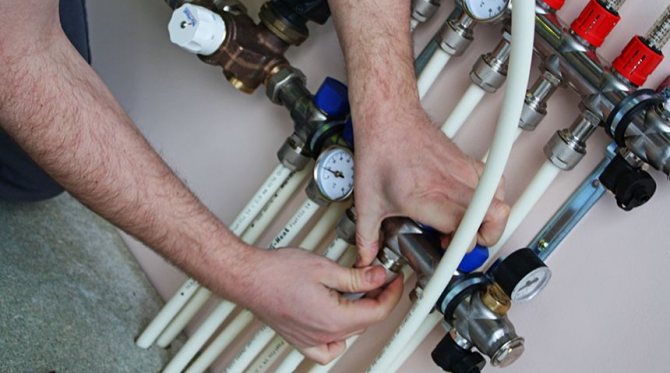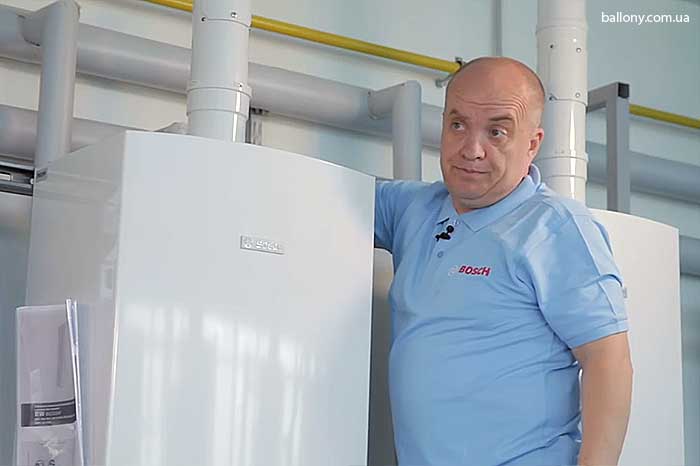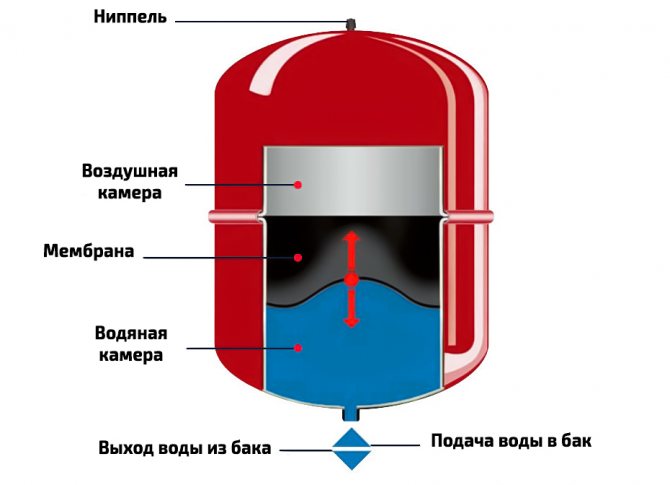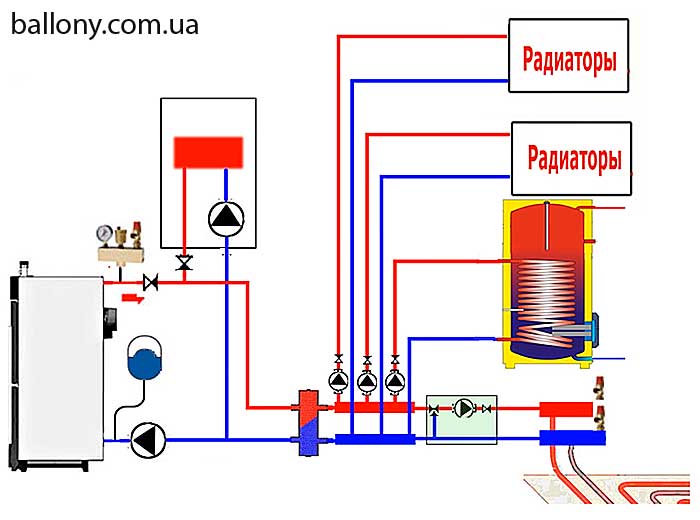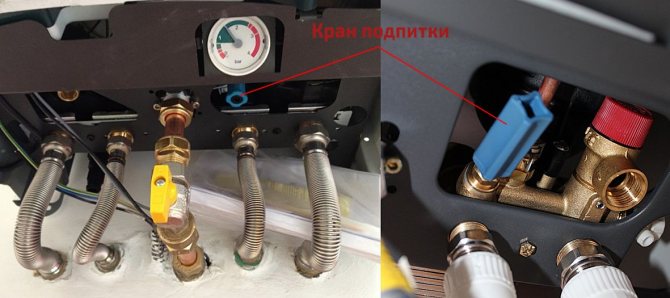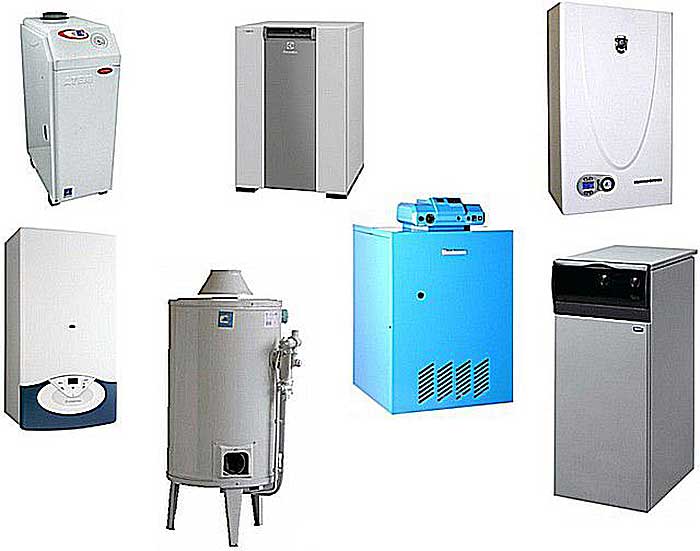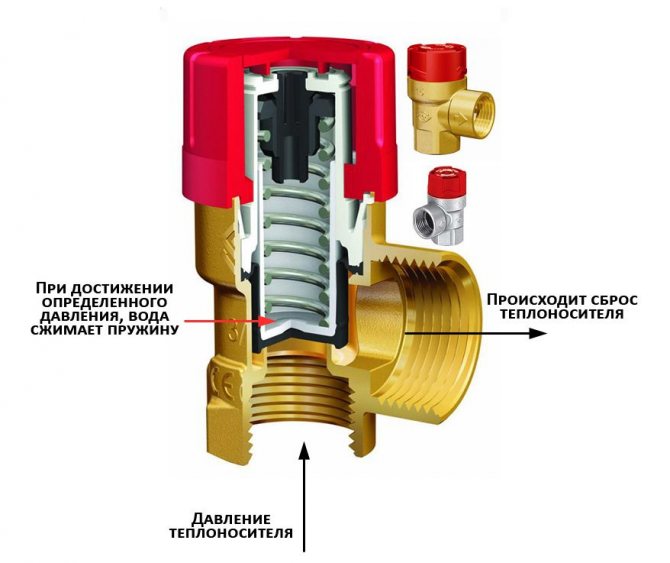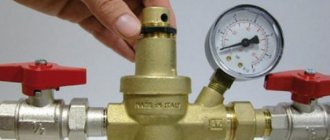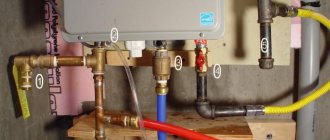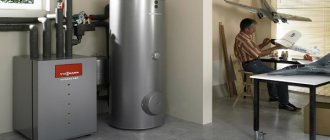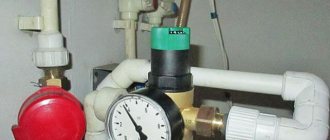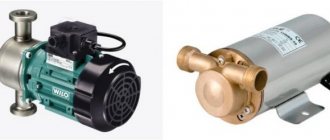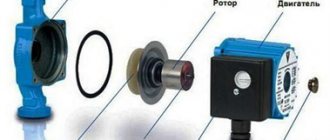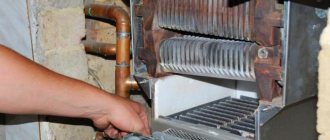Work on ensuring the correct functioning of heating equipment does not end with its installation. Maintenance requires a certain level of knowledge from the owner and constant monitoring of the state of the system. It is important to understand why the pressure in the gas boiler drops or rises, why the equipment functions with differences.
The article presented by us describes in detail all the reasons for pressure instability in the heating agent and hot water preparation system. We will show you how to troubleshoot and keep the readings in the normal range. Our recommendations will help you cope with emerging breakdowns and prevent malfunctions.
What should be the pressure in the heating system
Heating systems can be divided into two types - closed and open. When open, the pressure regulation function is performed by a leaky expansion vessel.
The tank is installed at the top point of the heating circuit and serves to hold the heat carrier expanding during heating, to remove air, and also acts as a safety valve. The operating pressure in such a system depends mainly on the temperature of the heating water.
Most often, when organizing heating in houses and apartments, closed heating systems are used. They are more effective, safer, but require constant pressure monitoring.
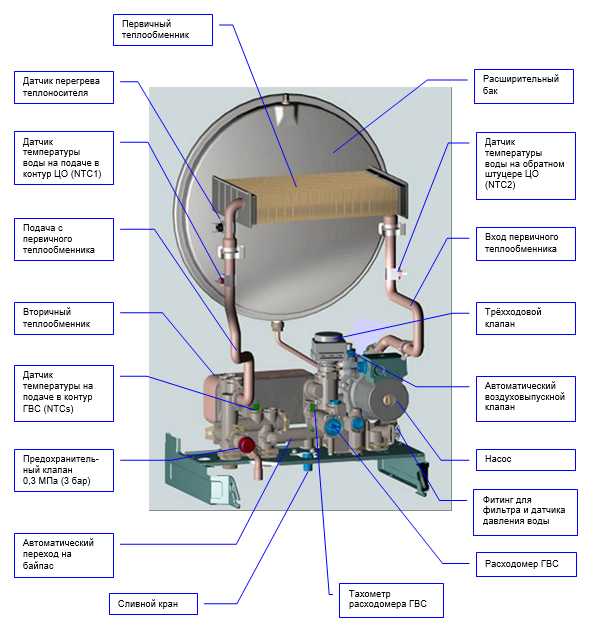
It is very important to monitor the pressure, temperature of the coolant, respond to any signs that are not characteristic of the normal operation of the heating system - knocking, frequent discharge of hot water through the safety valve, cold sections of the circuit
The head in a closed circuit occurs due to forced circulation carried out by a pump. Abnormal pressure can lead to equipment failure.
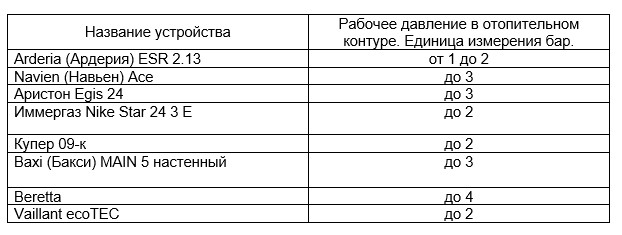

The nominal pressure in gas boilers of various models may vary, it is determined by the technical characteristics of the equipment
When designing a heating system, the pressure is calculated taking into account the height of the water column, the length of the system, the characteristics of the connected equipment, and the cross-section of the pipes.
To adjust the working pressure, you need to focus on the following parameters:
- Technical characteristics of a gas boiler. The manufacturer indicates the capabilities of the equipment and its settings in the instructions.
- Heat carrier temperature. The higher the temperature, the greater the pressure in the circuit; as it decreases, it decreases. Therefore, the adjustment and measurement of pressure in the gas boiler and the heating circuit must be carried out before and after heating the coolant.
- The volume of the circuit and expansion tank. The size of the accumulator has a direct effect on the pressure in the heating circuit, on the range of its fluctuations.
- Allowable pressure values for the least "weak" element "of the system. The pressure in the system should not exceed the permissible values for each of its elements. For example, polypropylene pipes, which, on average, are designed for a pressure of 25 bar at room temperature of the coolant, at a temperature of 90 ° C withstand an increase in pressure only up to 7-9 bar.
The minimum pressure in the circuit can be 0.5-0.8 bar, the exact standard values are indicated in the instructions, in accordance with them the pressure sensor is adjusted to the required value. If the pressure in the heating system drops below 0.5 bar, an emergency situation arises, in which a shutdown or damage to the gas boiler is possible.
The highest pressure in the system is up to 3, rarely up to 4 bar.For a five-storey building, pressures are set up to 5 bar, for a ten-storey building up to 7 bar. When making settings, it is necessary to adhere to the difference in pressure between the outgoing and return pipes - it should be 0.3-0.5 bar. After starting the heating, check if this is the case.
Question about the make-up tap
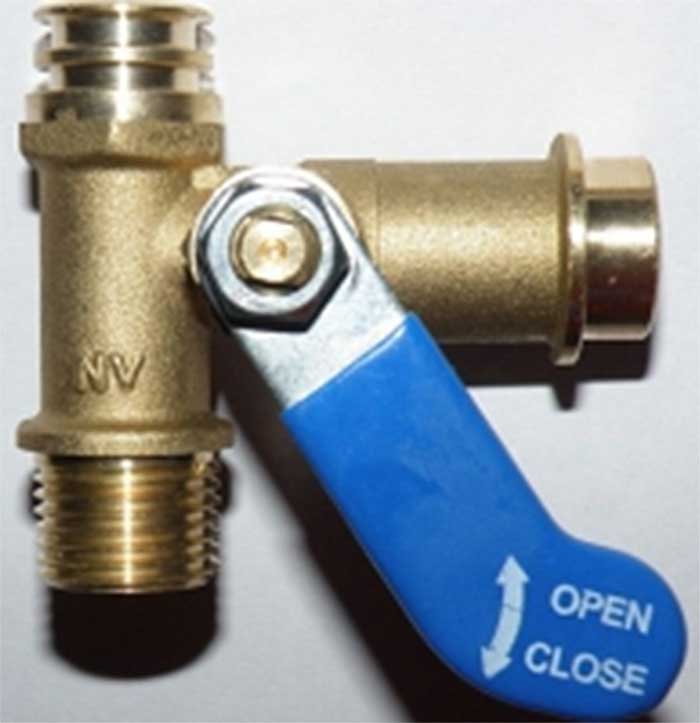

If the boiler feed valve does not work, the water pressure in the network will seriously increase. This requires professional diagnostics.
A temporary solution here is blocking the valve supplying water at the inlet to the GK. But in this situation, the use of hot water is excluded.
In order not to endure such discomfort, you need to replace the make-up tap.
This tap is the most important element in a double-circuit boiler. It feeds the pressure in the heating circuit. And the apparatus works flawlessly in all its modes.
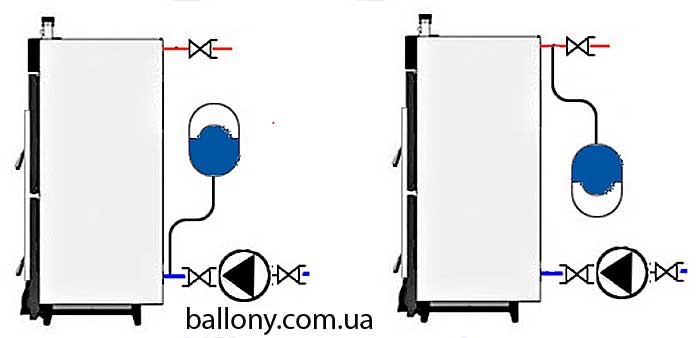

There are two categories of such cranes:
- First. Manual make-up.
- Second. Automatic recharge.
The regulation of water pressure in a gas boiler using the first category of taps is done manually. As required, you can develop the pressure in the gas mixture and maintain its stable indicators of 0.5 - 1.5 bar.
Cranes of the second category are usually found in premium devices. They control the pressure without the participation of the owner, on the machine. They are triggered by a signal from a special relay built into the boiler. The voltage required to activate it comes from the control board over the device.
Both classes of these valves are made of brass. Although today analogues from polymer plastic are becoming more and more widespread. Their prices are lower, and the functionality is not worse.
Due to a faulty make-up valve, the GK pressure not only rises. But it can also drop rapidly, especially when the DHW is started. This is the answer to the question - why does the pressure drop in the double-circuit boiler when hot water is turned on?
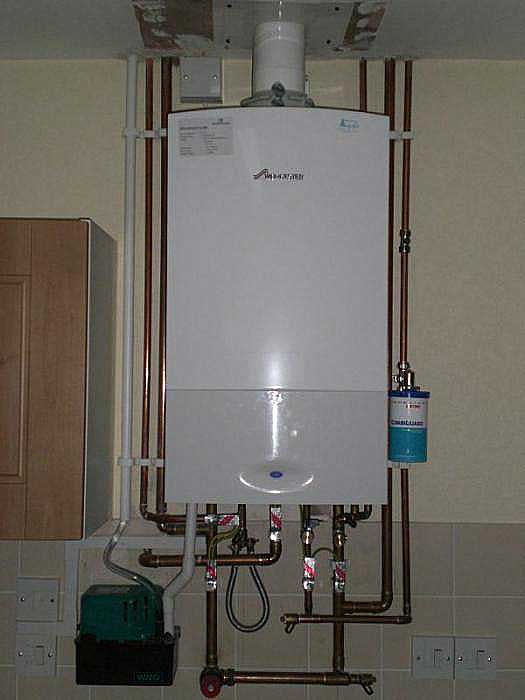

This tap needs to be replaced. It is carried out only by specialists.
The second reason for this is problems with the heat exchanger. It requires high-quality diagnostics and repair, if necessary.
How to check the pressure in the boiler and the circuit
Control over the pressure in the system is carried out using instruments that measure and reflect the pressure in the circuit using a digital or mechanical dial. The sensors are installed by the manufacturer on the boiler outlet.
During the installation of the system, pressure gauges are also installed near the collectors that distribute the coolant to various parts or floors of the building.
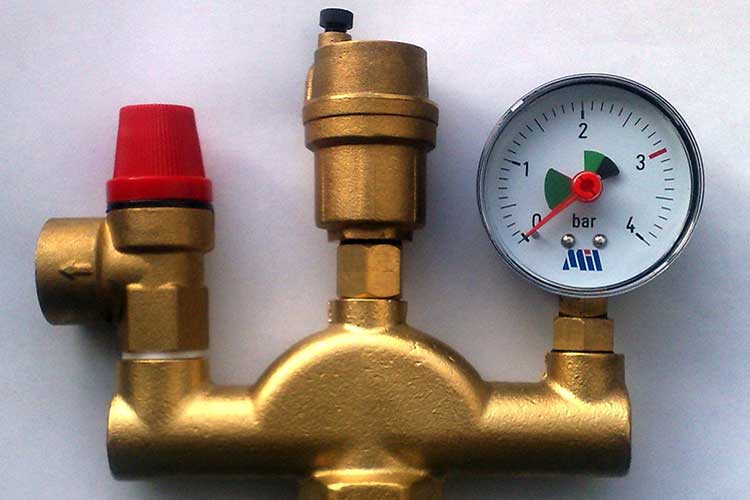

A safety group for boilers in the heating system helps to control the temperature regime, the pressure in the circuit, protects the equipment from destruction, diverting excess pressure outside
Additional pressure control is required when using boilers for heating water, in underfloor heating systems. A drop or increase in pressure can be observed in different ways in different parts of the heating system.
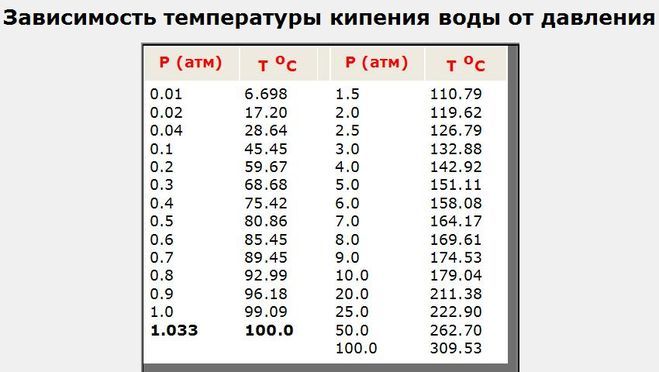

The closed loop allows to increase the pressure in the system, which increases its safety, since at higher pressure the boiling point of the liquid increases
When starting the gas boiler, check the manometer readings while the heating water is still cold - the pressure should not be lower than the minimum value, which is indicated by the red adjustable arrow of the manometer. The setting is carried out by a representative of the company with which a contract for service and gas supply has been concluded.
The initial setting is made when the heating is first started. In the future, the pressure is checked every week, if necessary, the system is fed with water. Make-up is carried out at a coolant temperature below 40 ° C.
How pressure is controlled
The optimal value for a gas boiler heating system is 1.5-2 atmospheres... If the sensors show a value outside these limits, then the situation becomes critical and promises equipment breakdown.
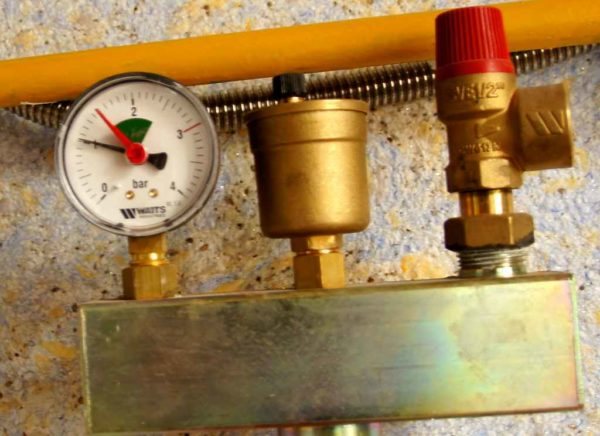

The control of such an indicator is provided by the installed in the system
gauge, pressure gaugeequipped with by Bredan's pipe... Mount this device at special points specified in the regulatory documentation for the equipment. In addition to displaying the pressure level in the system itself, such devices allow you to detect those areas in which there are leaks or other kinds of malfunctions.
For relax replacements pressure gauge and the possibility of unobstructed reset indicators, as well as blowing it, the working medium is directed to it through three-way valvesrather than directly. Devices are installed either before or after the nodes, which in case of breakdown affect the pressure level in the system. It also allows diagnose performance this or that unit.
Reasons for an increase in pressure in a gas boiler
In addition to the pressure gauge, frequent discharge of water through the safety valve and blocking the operation of the device help to detect an increase in pressure in a gas boiler. Having determined the high pressure, first of all, excess air is dumped through the Mayevsky taps and the boiler is turned off. There can be several causes of malfunctions.
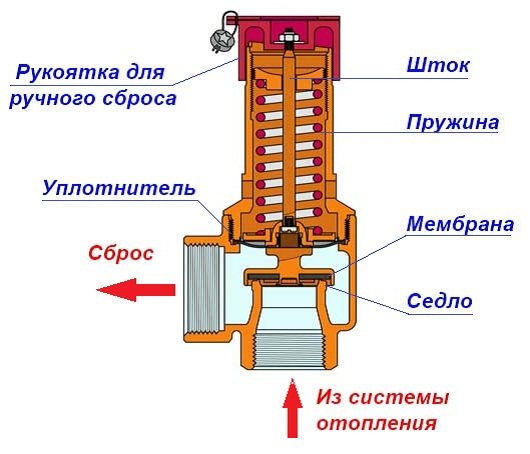

The normal upper pressure value is provided by the system by dumping the excess heating medium through the safety valve into the drain
An increase in the pressure in a gas boiler can be caused by damage to the partition of the secondary heat exchanger, which simultaneously serves to isolate and increase the contact area of two circuits - heating and hot water supply.
The secondary heat exchanger draws water from the heating circuit for the preparation and supply of DHW in a double-circuit boiler. Damage to the partition leads to the pushing of water from the DHW circuit into the heating system, increasing the pressure in it.
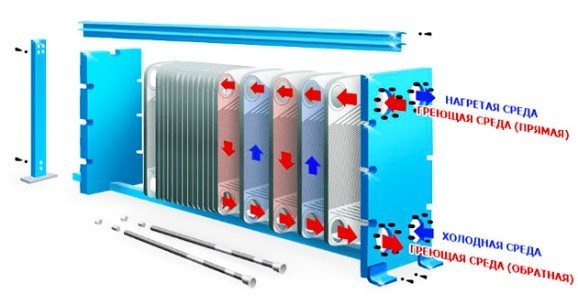

The secondary heat exchanger serves to service the hot water supply system. The DHW water heats up as a result of contact with the heating medium in the heating circuit. A metal baffle protects the system from mixing the two circuits, damage to which leads to the exchange of fluids and disruption of normal pressure
Replacing the heat exchanger will solve the problem. It is possible to carry out repairs on your own, but it is undesirable to do this, since interfering with the operation of gas equipment requires knowledge and experience in this area. In addition, self-repair of the boiler will deprive you of the right to warranty service.
A failure in the operation of the automation of the gas boiler or a loose impeller of the pump, which sucks in air, also increases the pressure in the gas boiler. Equipment malfunctions that lead to abnormalities in the normal pressure may be the result of a factory defect, breakdown of the control board, or an incorrectly configured system. Only a qualified technician can fix this kind of problem.
If there is no expansion tank
The expansion tank for the domestic heating network is the second most important element (after the boiler). Water, with a change in temperature, changes in volume. The volume inside the circuit is always constant, therefore, an expansion tank is additionally connected to the circuit, where excess coolant can be diverted, i.e. performs the function of a compensator. Consequently, RB is a safety device that prevents emergency situations - an increase in pressure, depressurization of pipes, etc.
The use of boiler equipment without an expansion tank is highly discouraged.
For stable operation, the pressure of the RB must correspond to the volume of the system, since when replacing radiators with pipes, the volume of the coolant must be increased. At the same time, too large RB will not maintain the operating pressure in the circuit.
The standard is an expansion tank, designed for 120 liters of heating medium in the circuit (typical two-room apartment).If the tank is too small, then the water will be discharged during heating and expansion through the safety valve. When the boiler is turned off, when the liquid temperature decreases, the boiler will not start up, because its volume, and, therefore, the head will be insufficient. In such cases, additional power supply is required.
https://youtube.com/watch?v=tgwLKEVRgYk%3F
Increasing the pressure in the heating circuit
What to do if the pressure in the heating system rises excessively?
First of all, you need to establish the reason, and there may be several of them:
- Incorrect filling of the circuit, its airing. Due to the rapid filling of the heating line, air locks can form in it. To avoid this phenomenon, fill it slowly when starting the heating.
- The temperature in the circuit is too high. Any increase in temperature and coolant leads to its expansion and an increase in pressure in the system. It is necessary not to allow too much increase in order to protect the heating equipment from critical loads.
- Stopping the movement of the coolant. The reason may be a closed shut-off valve, blockage of the mud filter, air locks.
To identify the problem area, it is necessary to examine the entire contour step by step.
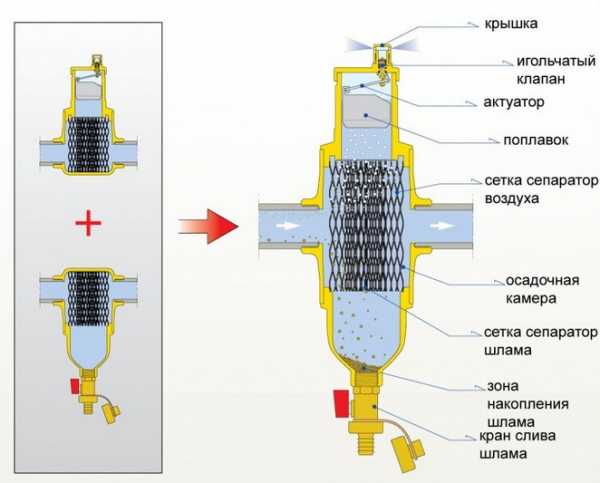

It is necessary to check and clean the filter immediately after the first start of the boiler, and then again after a week. Further, routine checks and cleaning are carried out once a month or season, depending on the degree of contamination of the coolant
Leaks can be caused by a breakdown of the make-up valve - wear of the valve gasket, mechanical damage to parts, scale trapped between the seat and the gasket. If the tap passes, then the excess water coming from the water supply system to the heating main increases the pressure in it, because the pressure in the cold water supply is always higher. It is necessary to tighten the tap or replace it if it fails.
Air locks are a common cause of heating system problems. They can be caused both by malfunctions of the gas boiler itself, as well as problems in the circuit or improper start of heating.
Restarting the system will help to troubleshoot - its slow filling with coolant, starting from the lowest point, until water flows from the top point of the circuit. At the same time, all air bleed valves must be open. Airing the system can lead to both an increase and a decrease in pressure.
Air lock as a cause of pressure increase
Another possible reason why the pressure itself rises is the presence of air in the heating circuit.


Airborne exposure can occur due to:
- when the heating circuit fills up too quickly with liquid - the system should be filled slowly, with the air release valves open. The valves are open until liquid flows from the highest point of the system;
- Mayevsky's taps are broken, change taps;
- the impeller of the circulation pump has become loose, because of this, air may enter, adjust the impeller.
The main reasons for the decrease in pressure
Common reasons why the pressure in a gas heating boiler drops are:
- Coolant leak. Damage to the heating main leads to a leakage, loss of heating water and a decrease in pressure.
- Cracks in the heat exchanger. Leaks in the boiler itself will not only lead to a decrease in pressure, but can also provoke more serious equipment breakdowns, damage the electronics.
- Diaphragm rupture in expansion tank. Through damage in the rubber baffle, the liquid enters the air compartment and the pressure in the circuit is reduced.
To determine the place of a leak in the system, it is fed to normal pressure and the operation of the circulation pump is stopped. Step by step it is necessary to inspect the highway, identify the problem area and troubleshoot.
Baksi boiler pressure drops when hot water is turned on
Sometimes, users face a problem when the pressure drops when hot water is turned on in the baxi boiler. This problem may just be associated with insufficient pressure in the expansion tank. The fact is that when the boiler is switched to the hot water preparation mode, the circulation pump pumps liquid in a small circle, i.e. only inside the boiler itself - through a secondary plate heat exchanger. At the same time, the heating circuit does not actually heat up and the coolant begins to cool down, the volume decreases and in the absence of compensating pressure in the expansion tank, the pressure of the heating system may drop and the boiler will have an error e10.
In such a situation, you can still consider the option of a breakdown of the heat exchanger itself (a gap between the plates) and the ingress of water from the heating circuit into the DHW system, but this is easy to check. To check, you need to turn off the cold water supply to the boiler and open any parsing valve. If, under such conditions, water flows from the tap, it is obvious that this is a coolant from the heating circuit and the heat exchanger needs to be replaced.
How does the operation of a hydraulic accumulator affect pressure?
Expansion vessel problems that affect the head in the heating circuit are very common. Incorrectly calculated volume of expansomat is one of the most characteristic prerequisites.
Malfunctions can result in improper installation, low or high pressure in the air chamber of the tank, damaged diaphragm - each of the reasons can lead to disruption of the circulation of the coolant in the system.
Expansion tank: device features and volume
If a small tank is installed in the heating system, it cannot compensate for the expansion of the heating water during heating. At a temperature of 85-95 ° C, the water expands by about 4% and its excess volume is released through the safety relief valve.
In order for the expansomat to fully perform its compensatory function, its capacity for systems with a gas boiler must be at least 10 percent of the total volume of water in the circuit.
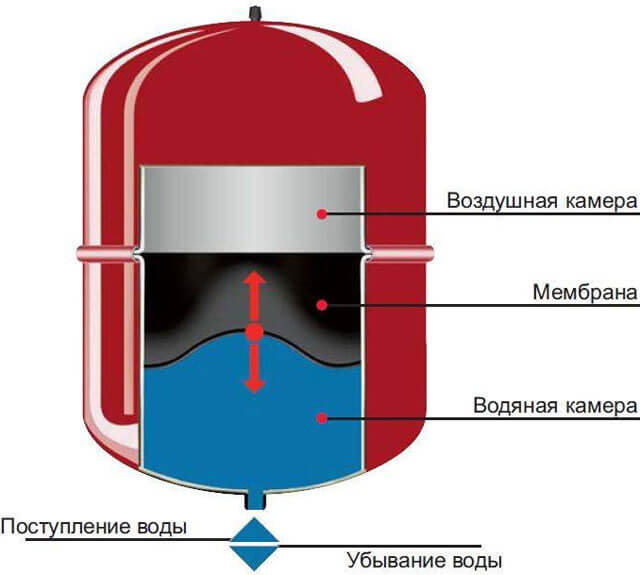

If you install a tank with a volume of more than normal, then the pressure fluctuations will be even less. Reducing pressure drops has a positive effect on the operation of the system and the service life of heating equipment
Damage to the tank membrane leads to the fact that water completely fills its volume and the pressure in the circuit drops. If you fill the volume of the circuit by opening the make-up valve, this will create a new problem - when the coolant heats up, it will not have much to expand and the pressure in the system will increase more than normal. The situation can be corrected only by replacing the rubber partition.
The tank should be installed only on the return pipe, in front of the heating boiler. So the tank will have a minimal effect on the operation of the circulation pump, which is installed after the gas boiler. In addition, here the water temperature is lower and the negative effect on the pressure in the system and on the tank membrane will be less.
Air chamber pressure setting
The pressure formed in the air chamber of the expansomat can also lead to an increase or decrease in the pressure inside the heating system. It is possible to check and pump air in the tank only if there is no coolant in the tank.
To do this, shut off the access to the common circuit with the help of shut-off valves and drain the water through the drainage drain. Then the pressure in the air chamber is measured and inflated / deflated to the required values.
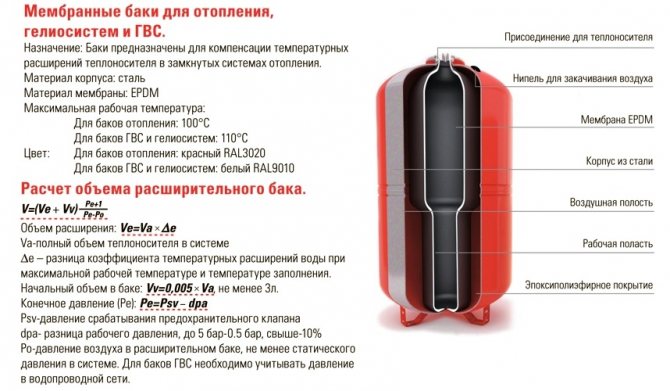

You can check the pressure indicators in the expansion tank using a car pressure gauge, pump it up using a car pump
To set the pressure of the expansion vessel, the air chamber must be 0.5 bar higher than the expected maximum system pressure.After the pressure in the equalizing part of the tank is adjusted, the circuit is filled with cold water to the expected pressure.
Then the air from the air chamber is released until the pressure in the heating circuit and the tank starts to decrease simultaneously - here it is necessary to simultaneously monitor the pressure in the system and in the expansion tank.
In this phase, changes in indicators are hardly noticeable, therefore, it is necessary to be ready to immediately stop bleeding air from the expansion tank as soon as a simultaneous decrease is detected.
Do i need an expansion tank for the baxi wall mounted gas boiler?
The volume of the built-in expansion tank of the baxi boiler is indicated in the characteristics and for the ECOFOUR series is 6 liters, in order to answer the question of its need for a separate heating system - you need to know the total volume of this system.
It is not so difficult to calculate it: the filling volume of the boiler and radiators is in their characteristics, and the filling volume of the pipelines can be calculated knowing their diameter and total length. Water, after heating to 80 degrees Celsius, will increase in volume by about 4-5%, therefore, the recommended volume of the expansion tank is 8% of the total volume of the heating system in the case of filling with water and 12% in the case of using antifreeze as a heat carrier (thermal coefficient expansion of antifreeze more). Thus, a standard expansion tank will be sufficient for a heating system with a volume of up to about 75 liters when using water and a volume of up to 50 liters when using an anti-freeze liquid.
The reason for the pressure drop in the presence of air
Heating equipment and systems are often faced with a drop in pressure. This may be indicated by the presence of air. If there are plugs, then the technical requirements for the process of filling the system with water could be violated. Sometimes the coolant is poorly prepared, as a result of which a certain volume of dissolved air remains in it.
The coolant can be airborne, in this case suction occurs, and the connections remain not so tight. Sometimes it also happens that the air relief valve from the heating system does not work correctly, it may be poorly adjusted or clogged. Each of these problems can cause noise in the system. This phenomenon cannot be called normal, in addition, it is harmful to heating.
How to bleed an air pocket from a radiator without losing pressure
First, you need to locate the air pocket. It is easily localized by the characteristic gurgling sound accompanying the flow of the coolant through the airy area. After that, it would be a good idea to record the initial pressure by reading the readings on the pressure gauge. We will be guided by this indicator before raising the pressure in the boiler, after eliminating the air bubble.
Switch off the boiler or circulation pump (if the latter is not included in the heater). Pressure equipment generates an impulse in the heating network, ensuring circulation, and when etching an air pocket, this effort will be superfluous.
Next, substitute a bucket or basin under the Mayevsky faucet of the air-conditioned battery and turn its valve in the direction of the arrow in the desired direction. Air will first go through the hole in the faucet (with a hiss, as from a descent balloon), and then water will drip. But do not rush to close the tap - after a small portion of water, air will come out of the battery again. Close the valve only after making sure that only water is coming from the faucet.
Then read the current pressure value on the manometer (it will be less than the initial one) and open the valve for supplying water to the distribution from the water supply system, monitoring the readings of the manometer. As soon as they get close to the starting mark (we wrote it down earlier), close the water supply valve. Now turn on the boiler (pump) and listen for the noise in the batteries.If you hear a murmur or gurgle, do all the above manipulations from the very beginning - until the gurgling sounds completely disappear when water moves through pipes and radiators.
Checking the health of the heating boiler
If no problems are identified in the network, and the pressure drop continues, then it is worth checking the boiler equipment. It can only be serviced by a specialist who has the appropriate education. If there is no pressure, or it supplies constantly, but not abruptly, then it is necessary to periodically recharge the system. Problems can arise from small cracks in the boiler heat exchanger. They appear due to a factory defect, due to water hammer, breakdown of the make-up valve, etc. Time for adaptation of the heating system after start-up:
- You should be aware that the pressure in the heating system, which has just been started, drops constantly, this is the norm. Don't worry about this. These drops are caused by the air dissolved in the coolant, which comes out gradually in automatic mode, or you can release it from the radiators manually. After that, you need to add water to the network, at first you need to do this, but this way you can increase the level to normal indicators;
- If, after the equipment was started, four weeks have passed, and the pressure disappears, or there is no pressure at all, then the problems may be hidden in the wrong choice of the expansion tank volume. If this is the case, then the safety valve is triggered and water is discharged, and when the heating device cools down, a drop in performance occurs. In such circumstances, to increase the pressure, the expansion tank must be changed;
- If the volume of the tank meets the parameters of the heating system, then problems with a drop in water pressure may arise due to the fact that the network is depressurized. Eliminating water leaks in a heating device helps to solve the problem of pressure drop.
"Why does the pressure drop in the heating system and how to return the pressure back?" - if you are interested in this issue, then some trouble has happened to your heating system. But do not be discouraged, this is a fixable matter. Now we will deal with the causes of the pressure drop effect, and with ways to eliminate such a failure.
Air heating
The room is heated thanks to batteries that are in each room. Depending on what material is used, the equipment can be:
- cast iron;
- aluminum;
- bimetallic;
- steel.
When considering heating equipment and systems, it is better to prefer bimetallic radiators, as they have excellent heat dissipation. Water enters the heating devices through a branched system. To ensure a fast and uniform movement of water, it is used. Systems where the coolant moves by gravity work on the same principle. In this case, the air relief valve from the heating system acts as one of the important elements, this should also include pressure gauges, as well as shut-off valves.

